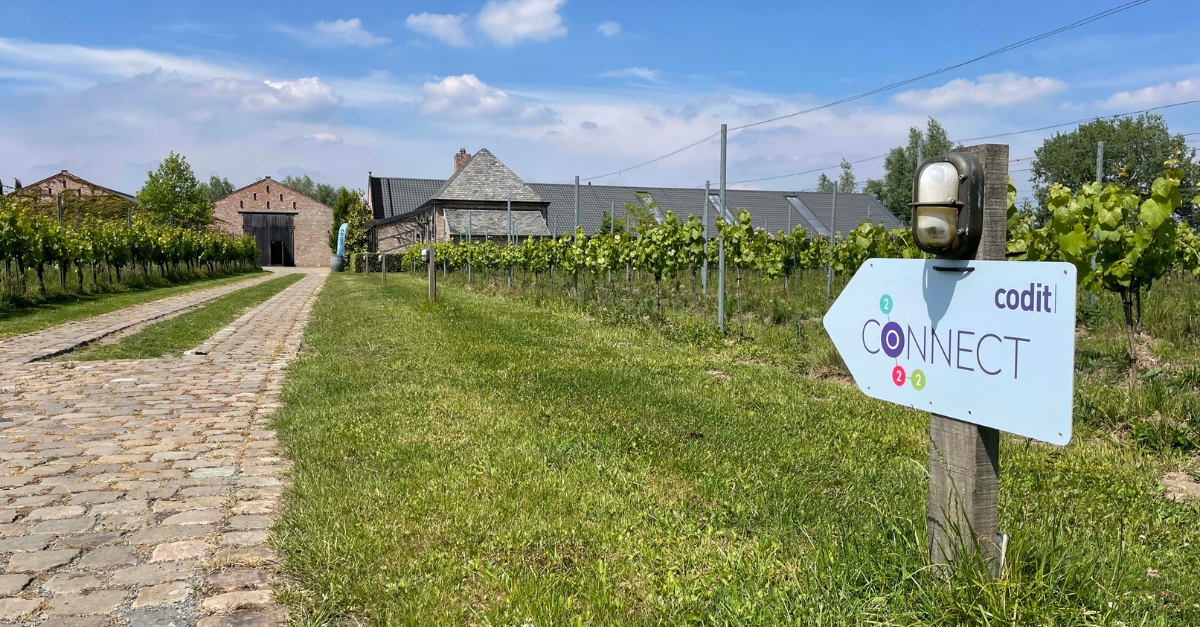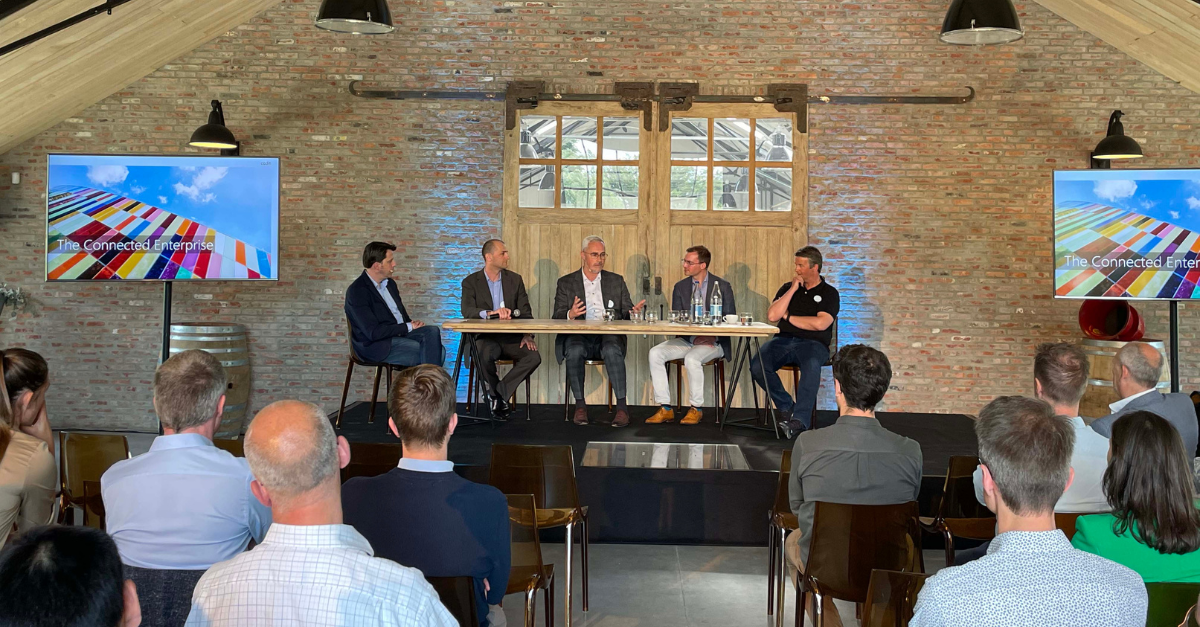The Connected Enterprise
To kick off this year’s talks, Hans Constandt, Program Manager at the Belgian Health Data Authority discussed Key Points for Designing the Connected Enterprise. He is currently supporting the Belgian authorities on the use of data for healthcare.
- At the moment, there is a lot of data in healthcare and indeed in most industries that is scattered and not standardized. Information about a single patient is siloed, spread across hospitals, physicians and machines without being accessible at one central point. This can be inconvenient and sometimes life-threatening for the patient.
- Although data lakes promised to make it easier to process data, the data stored there is still in too many places to be simple; in other words, it’s clean but unstable. Moreover, in healthcare as in all industries, there are many different groups wanting to use the data for different reasons.
- The objective now is to turn the data collected into something that can create value. 90% of work in data science is about curating the data collected, and if your data is bad, your machine learning tools are useless. Collecting data is simple: the real benefit comes from data integration.
- The best approach to using the data intelligently can be summarized by the acronym FAIR, which stands for the fact that data should be Findable, Accessible, Interoperable and Reusable. FAIR lengthens the life of data, sorting it into low to high value so that it can be used in the more intelligent way.
- In healthcare, this approach means that object is to use data not only for today’s cures, but for preventative care – connecting a patient’s information from cradle to grave.
Disclaimer: All of the opinions expressed are Hans’ own, and not those of the Belgian Health Data Authority.

Following this, Hans joined a panel discussion between Pepijn Karsmakers, CIO of Azelis, Jan Peeters, CEO of Portima and Codit’s Integration Specialist Peter Borremans. They spoke about the Connected Enterprise as the power to drive their respective companies forward in the digital transformation journey.
- The aim of a truly Connected Enterprise is to unite technology, process, data and people: to be “digital with a human touch”. This also means there is both a business and technical driver behind the Connected Enterprise for companies.
- Over the past few years, there has been a large movement toward cloud-centric architectures. These require accessible products by exposing and consuming API’s. The API layer and API Management platform have become a crucial part of the integration architecture. API’s make your products ready to be accessible and interoperable between applications, platforms and devices. The business driver is that this saves on both cost and time, and can help companies to create accessible products and increase security. Building this is where companies like Codit come in.
- One of the main business challenges faced in implementing the Connected Enterprise is investment in talent. For the front-end to be kept up, there needs to be back-end support, and this requires talent and investment.
- There is also the issue of cultural and organizational change. This can be particularly difficult when dealing with customers not accustomed to new processes. However, it is clear that this change is coming, so the systems must be designed to be flexible and to be able to scale up in order to keep up with their competitors.
- On the technical side, a challenge is how to keep up with rates of change in tech. At Codit, we invest more R&D to discover and learn about new products and capabilities.
- With all of this change, companies must also consider how to keep lead time under control. You can do this by engaging with a flexible partner: one who is organized to respond fast to customer demands. Other ways include implementing the Invictus framework, pre-building components to implement common integration challenges, installing reference architecture that already thinks ahead for monitoring & operations, and business monitoring out of the box with something such as Codit’s dashboard.
- In all, companies implementing the Connected Enterprise must ensure they have a capable platform. Besides the obvious capabilities, this includes on-premises like connectors, workflow automation, and transformation. Moreover, a cloud integration platform should go a step further and offer capabilities that couldn’t be delivered years ago. These include: virtual unlimited scalability; disaster recovery & resilience out of the box; geographical coverage; speed and security. By offering a large number of cloud services, companies can choose from the menu and pick the services they need.
- Overall, the best way to move forward as a company implementing the Connected Enterprise is to not be afraid of change and to keep things stable and simple.

The Cognitive Enterprise
Our second keynote speaker, Geertrui Mieke De Ketelaere, then spoke on Building the Cognitive Enterprise. Mieke is the Director of AI at imec (IDLab) and spoke on defining the projects that will create the highest impact. She explained how to move beyond the typical PPP (Pilot, POC & Prototype) phase while looking at some real examples and common reasons why AI projects can fail. Summary below:
- The Cognitive Enterprise is a smart combination of both artificial and human intelligence, with cognition referring to “the mental action or process of acquiring knowledge and understanding through thought, experience, and the senses”.
- We are still the early days of using and processing data and its potential uses are not transparent to the rest of the world. Consequently, not many companies understand the business challenge they are trying to solve by using it.
- As unstructured data is a core component of the Cognitive Enterprise, you have to make sure you have both data engineers and data scientists, the first to prepare the data, and the second to put it into action. Both must work together to produce the results.
- Once the data is produced, you can take valuable insights, from which to make valuable actions. The best sort of data-driven company is one where this pattern is circular; when new data comes in, you can create new insights and new actions.

Mieke then joined a panel alongside R&D Director of Duco, Koen Maertens, and Codit’s IoT Lead Steven De Lausnay, to discuss topics such as building successful IoT solutions and the use of data for analytics within their companies.
- Around 83% of companies understand that they need to be data-driven, but the issue at the moment is one of data quality and siloes. Dumping data results in bad data quality, which is not useful because somebody should take ownership of specific data, and in other cases, they can’t access the data because it is in a silo in another system (e.g. the supplier).
- We’re at an early stage of the move to the cognitive enterprise for many companies. This means that they work on a central monolithic platform, swamped with data that they don’t know what to do with, or where it’s come from, or if it is quality data. Moreover, at this stage many members of the team working with the data don’t yet understand the business value or the quality of the data.
- Another issue that arises with almost every customer at Codit is that they all want to know how they can connect their equipment. They struggle because a lot of equipment is old, with a lifetime of 20/25 years, meaning they aren’t yet IoT ready. For example, older, more established companies are finding themselves swamped with data because of their old legacy systems, where data is scattered everywhere. There has to be a balance though, because although a younger company isn’t stuck with such a legacy system, the older company will have an established base of customers. Codit helps these older companies to connect or use their legacy devices, or enable them to leverage the data that was already there.
- Duco is learning in real-time how their products are being used. By tracking the air quality and the performance of the system throughout the whole lifetime of the houses, they are arriving at a form of connected data. This service on air quality is marking them as an innovative and key player in the home-building market. Read more about Codit’s work with Duco here.
- The next stage is to do what was done with software development and move from a monolithic application to a microservice architecture. With this structure, the responsibility lies with different business units; those that build the products, and those who deliver end value to customers. They will become responsible for ingesting data and building high-quality data sets (correct quality, etc.) which can be consumed by end-users or customers. The challenge here will be of governance, but in an Azure environment you have the tools to deal with this. This is what energy company Engie is doing: moving to service-orientated structures, where they buy complete energy installations for residences and no longer sell only energy, but the other requirements such as gas or heat pumps. Read more about Codit’s work with Engie here.
- It can be difficult for companies to keep up with the constant evolutions in data solutions and buzzwords, such as Digital Twins, which is still at an early level of maturity. It’s a great solution when different industries or systems are coming together and there needs to be a central system to connect them all.
- Some companies are reluctant to adopt the cognitive enterprise because a lot of non-technical people are not literate to what it is. CEOs and CFOs need to understand how it works to a certain degree, and to know why it is important to invest in it now. A top-down approach is the only way the implementation can succeed. A common worry, GDPR, shouldn’t be a hurdle to the cognitive enterprise, as the infrastructure gives simple rules and a framework.
- If you’re ready to start incorporating the cognitive enterprise into your company, start small, don’t overthink it and make sure you’re constantly learning from failures. In this industry, changes can happen rapidly and so when you do fail, understand why and don’t waste any more time.
The day ended with a gorgeous selection of wines from Wijndomein Nobel, and some engaging talks with attendees in the sun. Thank you to everyone who joined us!
